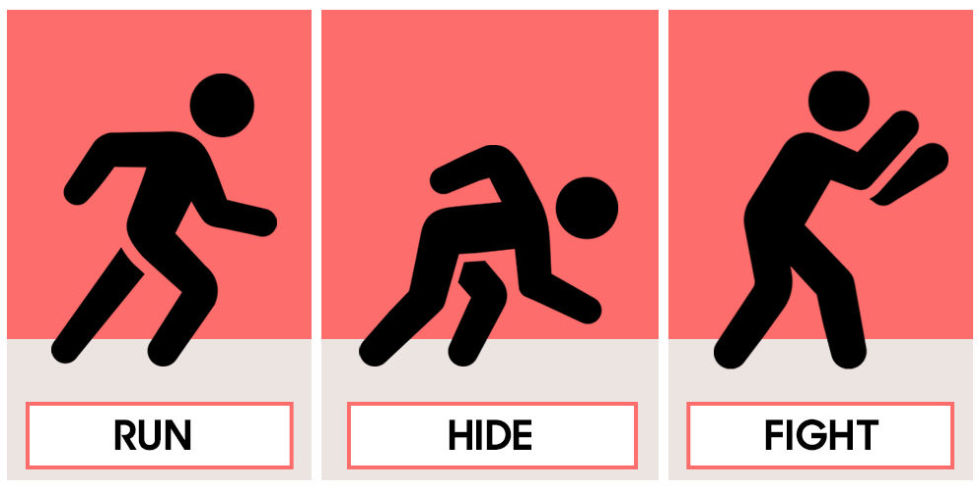It’s terrifying to think about your child ending up in a situation like the recent Marjory Stoneman Douglas High School in Parkland, Florida. Unfortunately, you should prepare your kids for “the possibility” of a mass shooting.
1. Teach your kids this mantra: run, hide, fight.
The idea is to provide basic, easy-to-remember actions in the event that people find themselves in an active shooter incident. “Run, which means evacuate. Hide means find shelter. And in the worst-case scenario, if you have to fight, fight to save your life.” (Think of it as “stop, drop and roll” for a different kind of emergency.) The steps are not necessarily intended to be done in order. Instead, which to take depends on your environment. “You can’t always find an escape route, so it may require that you find a hiding place that is out of the visibility of the shooter”.
2. Here’s another one: If you see something, say something.
As we go about our daily lives, the biggest mistake is not being aware enough of our surroundings to notice what might be out of the ordinary or not normal. “It’s reporting suspicious activity if something does seem out of place rather than going into that facility.” Also good to note: Tell your kids not to open locked emergency doors, no matter how nice the person asking to get in may seem.
3. Make sure your kid understands school protocol.
Schools now practice “lockdown” drills several times throughout the school year. In the drill, teachers lead students into a small, enclosed space, lock the door and tell them to be completely quiet. The shooter might come in if a sound is heard. “Know what your children’s school practices, and discuss it at home.
4. But it’s not all on the school — you can help too.
Meet with local law enforcement, school administrators and even the PTA. Ask questions about what parents should do in the event of a lockdown and who’s going to keep them updated and how. “Plan for what you’re going to do with the kids and how you’re going to effectively manage your communication with parents and law enforcement.”
5. If they can run, do it in a zig-zag.
A number one way to increase your chances of surviving. “A moving target is far more difficult to shoot than a stationary one”. A recommended technique – Running to something that could shield you from oncoming gunfire — think concrete pillars or behind a sink counter in the science lab — before sprinting to the next thing that could provide cover, until you’re out of the building. “If there is no cover, run in a zigzag motion as fast as you can to the first right-hand turn and get yourself out of sight,”. “That makes it very difficult for the shooter to be accurate.”
6. If they can hide, hide behind something concrete.
You may not always have a choice, but if you do, avoid hiding behind things made of plastic (think bathroom stalls) or other thin materials (cabinet doors, for example). “Think if I’m going to hide, I’m going to hide behind things that stop bullets like trees, structural pillars and big concrete planters”. If you’re outside and there are vehicles like a school bus, hide on the engine end, not on the trunk end. “Bullets can rip right through that trunk and still hit you, but the engine is going to stop it”.
7. If there’s nothing solid, at least hide out of sight.
Concealment could be your next best option. “That’s like hiding behind curtains, but the curtains aren’t going to stop a bullet”. If you’re in a room and it’s possible, “always barricade the door for extra safety”. “In a classroom, you should put filing cabinets on the same wall as the door and say, ‘Kids, let’s just slide this over.’ [Ideally] what’s going to happen is the shooter is going to give it some effort for a couple of minutes and then he’s going to say ‘Forget it’ and move on.”
8. When hiding, stay on hands and knees.
Whether you’re dropping down as an immediate reaction to hearing shots fired or crouching down to hide behind something, never put any vital organs against the floor. “Most bullets, when they ricochet, they follow the path of the floor”. “If a bullet comes flying, you’d rather have your hands, knee or wrist hit. If you put your lungs, heart or head right against the ground, you might get a ricochet bullet passing through your body.”
9. The bathroom shouldn’t be their first choice.
Another thing that may not be possible, but if it is, avoid boxed-in spaces like bathrooms, conference rooms and movie theaters. “Anytime there’s a confined space, get out of there”. [Public] bathrooms are horrible; they don’t usually have windows and there’s nothing in there that’s going to stop a bullet.” Another tip: Stay out of doorways.
10. The adults should fight as a group.
If you can’t run or hide, you still have the option of fighting (if you’re an adult). It’s risky but, “This is probably one of the worst scenarios that you could ever imagine, so you’ve really got nothing to lose.” Consider this: “It’s [probably] the bad guy’s first time to come through those doors and take people’s lives”. “He’s nervous, he’s not an experienced shooter. The reality is, with some confidence and knowing what you’re going to do ahead of time, you actually have more of an advantage, especially if you’re within striking distance.”

